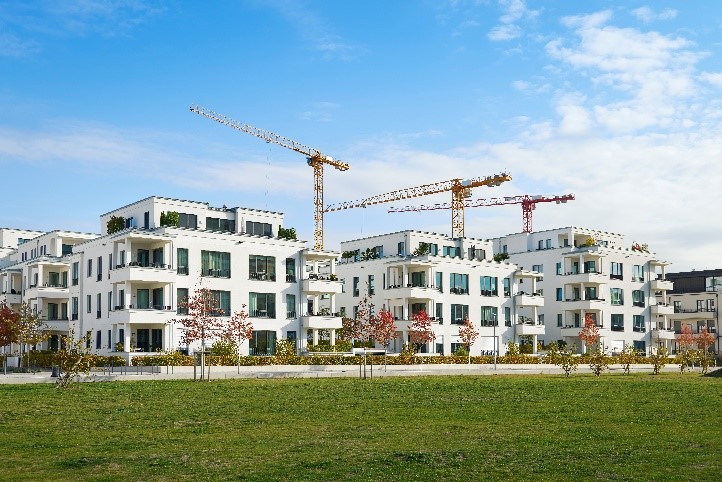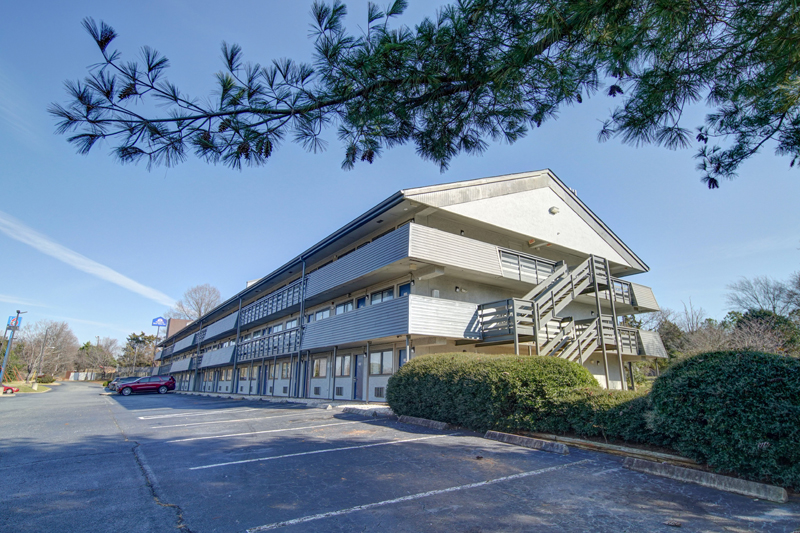Rent growth has decelerated below 1%, though stabilizing occupancy rates and increased consumer confidence bolster the market’s resilience. The Federal Reserve’s insights anticipate a slowdown in rental housing costs due to an influx of new apartments, aiding inflation management efforts. Adaptive reuse is reinvigorating urban cores, with a surge of 122,000 rental apartments undergoing transformation, reflecting evolving preferences and economic shifts. Cleveland’s metamorphosis demonstrates the potential of historic conversions and urban revitalization in reshaping investment opportunities.
Multi-family Rent Growth Slows Down, but Signs of Stabilization Emerge

As the multi-family rental market experiences a slowdown in rent growth, recent data suggests a potential leveling off after a period of decline. The shift in rent dynamics, though notable, is expected to find some stability in the coming months, according to insights from RealPage Chief Economist Jay Parsons.
Gradual Rent Growth Deceleration
Rent growth recently dipped below 1%, marking a significant shift from the trends seen since the aftermath of the 2010 Great Recession. Chief Economist Jay Parsons anticipates the possibility of further decreases in rent growth in the near future, although he also expects this slowdown to stabilize in due course.
Monthly Rents and Year-Over-Year Changes
Notably, asking rents have risen on a month-over-month basis throughout the entirety of the current year. However, the year-over-year rent change has been impacted by comparatively lower 2023 increases compared to the higher rates seen in 2022. This adjustment in calculation has led to a decrease in the year-over-year rent growth, hitting a low of 0.78%, the lowest figure recorded since July 2010.
Factors Behind the Adjustment
Parsons points out that this change is partly attributed to the larger-than-expected drop in rents between September and December 2022. This pattern implies that the year-over-year change figures could continue to decrease in August and possibly September before stabilizing to some extent.
Occupancy Rates and Consumer Confidence
Despite the rent growth slowdown, occupancy rates have remained stable throughout 2023, recovering from the drop experienced in 2022. Increased consumer confidence has played a role in driving demand upward this year, leading to an average national market rate apartment occupancy of 94.6% as of July.
Regional Disparities in Occupancy
Notable regional variations exist in terms of occupancy rates. The Midwest and Northeast have maintained occupancy rates above long-term norms. Conversely, the West and South have seen occupancy rates fall below these norms. For instance, cities like Salt Lake City, Portland, Oakland, and Austin, as well as Minneapolis/St. Paul has experienced drops of around 1.5 percentage points or more.
Select Markets Experiencing Rent Growth
While the overall multi-family rental market has slowed, a handful of the country’s largest markets have seen year-over-year rent growth above 2%. Most of these markets are located in the Midwest and Northeast. However, even these regions show signs of cooling, especially in cities like Miami.
Cooling Trends Across Regions
Geographical distinctions are apparent in the rate of cooling. The West Coast is experiencing a faster decline compared to the Sun Belt. A majority of Western markets (63%) witnessed year-over-year rent cuts last month, while the percentages were lower in the South (32%), Midwest (3%), and Northeast (0%).
Negative Rent Growth in Specific Markets
Specific markets have displayed negative rent growth, along with high supply levels. Examples include Phoenix (-5%), Las Vegas (-4.5%), Austin (-3.9%), and Jacksonville (-3.3%). Despite evident demand in these markets, the supply has exceeded it, reducing rent rates.
While this slowdown has affected various regions and specific markets, signs indicate a possible stabilization in the near future. Factors such as year-over-year calculations and regional demand-supply dynamics point towards signs of stabilization.
Anticipating Multi-family Rental Housing Cost Trends: Fed Research Signals Cooling Market

Recent findings from the Federal Reserve shed light on potential changes in the rental housing market that could impact the broader economy. The research suggests that rental housing costs might experience a notable slowdown over the next year and a half, signifying potential shifts in consumer behavior and economic trends.
Cooling Rental Market Impact
The influx of approximately 376,000 new apartments into the U.S. market during the second quarter is expected to temper the upward pressure on rental costs. These new units entering the market are anticipated to contribute to a slowdown in rent increases.
Shelter Inflation Outlook
Researchers at the San Francisco Fed have identified a trend that suggests shelter inflation, which measures housing cost rise, is likely to diminish in the coming year and a half. Their analysis is based on observing the recent slowdown in rental markets and changes in housing dynamics.
Implications for Inflation Management
The Federal Reserve’s efforts to manage consumer price inflation and achieve its target of 2% are expected to benefit from the projected slowdown in shelter inflation. This development could help the central bank in its broader goal of maintaining stable and low inflation levels.
Impact of Interest Rate Changes
The research acknowledges the impact of the Fed’s decision to raise benchmark interest rates, leading to mortgage rates surpassing 7%. This rise in rates has led to a decrease in demand for home purchases, which has implications for the housing market as a whole.
Complex Housing Supply Dynamics
While the slowing demand for home purchases has been observed, the housing supply situation remains intricate. Despite a limited number of home listings, the emergence of a substantial number of new rental apartments is expected to exert downward pressure on rents.
Market Insights from Data
Market analytics, such as those provided by RealPage and Apartment List, offer insights into the rental market’s direction. Private-sector data indicates a decline in annual rent growth, underscoring the trend of cooling rental costs.
Factors Influencing Forecast
The Fed researchers acknowledge certain caveats to their forecast. The forecasting models used are based on data from the unusual pandemic period, characterized by significant shifts in home prices and inflation. This acknowledgment highlights the inherent uncertainties in forecasting, but the identified trend remains noteworthy.
In conclusion, insights from Federal Reserve research illuminate potential changes in rental housing costs that could reverberate through the economy. The projected slowdown in shelter inflation has implications for consumer behavior and broader economic indicators.
Revitalizing Urban Landscapes: The Future Prospects of Adaptive Reuse

In the wake of the pandemic’s impact on urban dynamics, adaptive reuse has gained momentum as a solution to multiple challenges, from housing demands to revitalizing deserted city centers. The trend of converting older buildings into modern residences has garnered attention for its potential to reshape urban landscapes. While recent years have seen fluctuations in the pace of adaptive reuse projects, a deeper dive into the data reveals intriguing insights into this evolving phenomenon.
The Adaptive Reuse Upsurge
Adaptive reuse, or transforming older structures into functional living spaces, became a notable trend in 2019 and 2020. However, the momentum appeared to wane in 2021 and 2022, resulting in fewer conversions.
Reinvigorating Urban Cores
The emergence of adaptive reuse was driven by the need to address increased housing demand and revive underutilized downtown areas. Converting vacant structures into modern living spaces addressed housing needs and contributed to urban renewal.
Shifts in Conversion Patterns
Data analysis of Yardi Matrix data highlights that adaptive reuse apartments are poised for significant growth in the upcoming years. An impressive 122,000 rental apartments are undergoing conversion, with office repurposing accounting for 45,000 of these units.
Variability in Conversion Types
The number of converted apartments slowed in 2022, continuing a trend from the previous year. Previously a dominant force, office conversions experienced a 15% decline, while former hotels registered a remarkable 43% increase.
Office Conversion Challenges
The decrease in office conversions is tied to the uncertain future of office spaces due to hybrid work arrangements and changing demand dynamics. The conversion of office spaces into multi-family units focuses on smaller, older properties to align with construction costs and regulations.
Hotel Resurgence and Decline
Former hotels saw a surge in conversions, potentially due to a reduction in travel demand caused by the pandemic’s initial impact. However, hotel conversions are now competing with office conversions and might witness a slowdown as the hospitality industry recovers.
City-Level Insights
Cities such as Los Angeles, Kissimmee, and Alexandria have embraced adaptive reuse, contributing significantly to the trend. Los Angeles, in particular, leads the way with a robust history of adaptive reuse projects, contributing to the revitalization of the city’s landscape.
The Anticipated Surge
Despite recent fluctuations, future projections indicate a potential surge in adaptive reuse projects. Yardi Matrix data suggests that 122,000 apartments are poised for conversion, marking a 63% increase compared to 2021.
The Future of Adaptive Reuse: Insights from an Expert
Steven Paynter, Principal at Gensler, a leading design and architecture firm, offers unique insights into the future of adaptive reuse. Paynter emphasizes that the slowdown in 2022 doesn’t undermine the potential for a resurgence in the coming years, with a boom anticipated from 2024 to 2027.
Overcoming Challenges
Challenges in converting office buildings involve factors like floor plates, building height, and window placements. Urban governments are crucial in incentivizing adaptive reuse projects to promote downtown rejuvenation and historic preservation.
The adaptive reuse trend remains a captivating avenue for reshaping urban environments and addressing housing needs. While recent years have witnessed shifts and fluctuations, the underlying potential for adaptive reuse projects to thrive remains promising. A combination of urban policies, market dynamics, and the evolving preferences of residents and businesses will likely influence the future of this trend.
Cleveland's Evolution

Still Cleveland?
The real estate investment landscape is ever-evolving, often driven by economic shifts and demographic changes. In recent years, Cleveland, a city historically seen as a secondary market for multi-family development, has undergone a remarkable transformation. Fueled by strategic conversions, booming construction projects, and growing demand for urban living, Cleveland has reinvented itself, challenging preconceived notions about its investment potential.
Shifting Perceptions
Historically, Cleveland was considered a secondary market with a declining population and subdued economy, making it less appealing to multi-family investors. The city’s past reputation as a commuter-centric urban center shifted when the Great Financial Crisis of 2008 led to an oversupply of office spaces and opportunities for redevelopment.
Rise of Urban Living
Before 2008, Cleveland’s central business district (CBD) was primarily associated with office spaces rather than urban living. Developers seized the opportunity presented by vacant office spaces and converted them into multi-family properties, sparking a renaissance in historic conversions.
Historic Conversion Renaissance
The success of converting industrial warehouses in the historic warehouse district into apartments paved the way for transforming historic office assets. Over a decade, historic office conversions to multi-family dwellings more than doubled the CBD’s population, attracting millennials and young professionals.
Strong Absorption and Demand
The absorption rate for these converted buildings has been impressive, with most stabilizing in under a year. This reflects the growing demand for an urban lifestyle that balances work, leisure, and residential needs.
Catalyst for New Construction
Ambitious projects like The Flats at East Bank kickstarted new construction ventures, not just within the CBD but also in surrounding neighborhoods. High-profile developments like The Lumen, INTRO, Bolivar Apartments, and City Club Cleveland further validated Cleveland’s transformation.
Future Forecast and Investor Interest
A report commissioned by Downtown Cleveland Alliance and Greater Cleveland Partnership suggests the CBD can support thousands more apartment units. Investor interest in property sales and acquisitions has surged, driven by solid rental market fundamentals, the renowned healthcare industry, and affordable living costs.
Fun Times in Cleveland Today
Cleveland’s ascent from secondary market status exemplifies the dynamism of the real estate industry. The city’s ability to capitalize on historical conversions, embrace new construction, and cater to the demands of a changing demographic landscape has turned the once-overlooked urban center into a beacon of investment opportunity. As cap rates tighten and the city’s appeal continues to grow, Cleveland showcases the potential for transformation even in markets previously deemed secondary.
Boston Multi-family Portfolio Sale Reflects Strategic Divestment Amid Market Shifts
Strategic Disposition
Harbor Group International (HGI), a prominent real estate investment firm, successfully offloaded a 1,722-unit multi-family portfolio in metro Boston. The deal was sealed with a Bridge Investment Group Holdings Inc. affiliate, showcasing the art of identifying promising value-added opportunities.
From Vision to Value
HGI’s 2019 portfolio acquisition for $384 million marked the inception of a comprehensive transformation journey. A $13.6 million capital improvement initiative drove the portfolio’s rejuvenation, focusing on enhancing interior units, amenities, and overall aesthetics.
Prime Locations
The multi-family properties, strategically positioned in the Boston metro area, are surrounded by bustling employment hubs and well-connected transit options. The locations’ connectivity and convenience added substantial value to the portfolio’s appeal.
Unlocking Upside Potential
The portfolio’s astute purchase at an earlier valuation paved the way for organic rent growth and increased property value. HGI’s strategic move in identifying opportunities for high-quality assets divestment underscores its acumen in navigating evolving market conditions.


